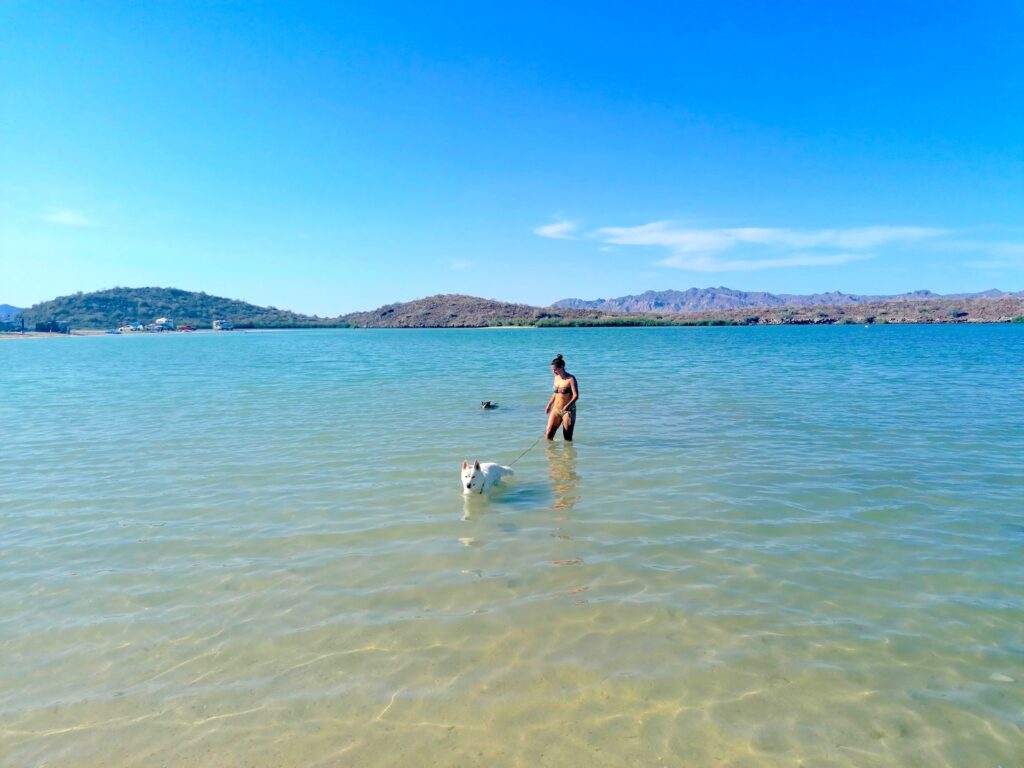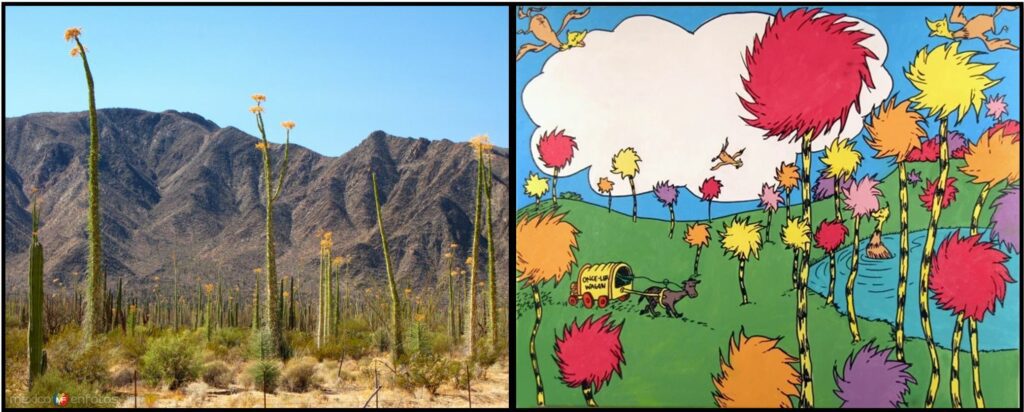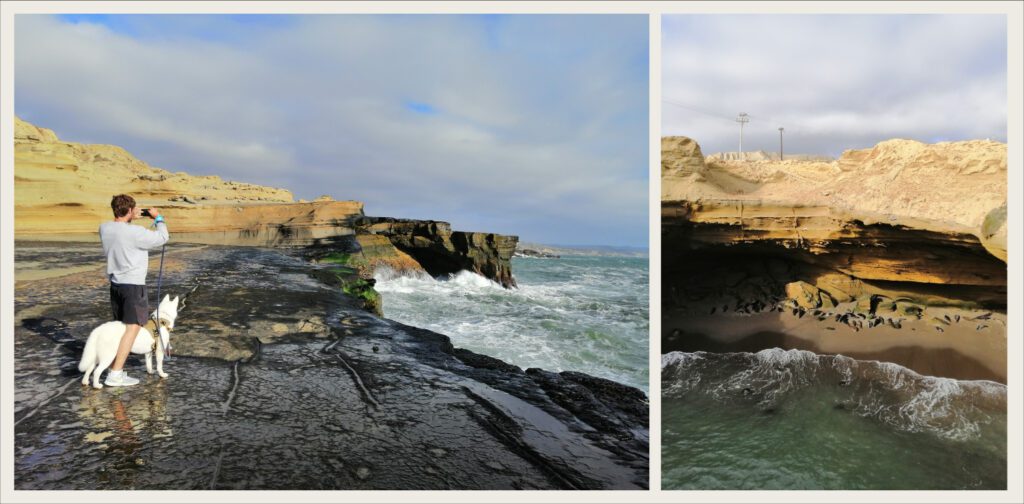Los Cabos is the most know destination of the Baja Peninsula, followed by Valle de Guadalupe, but there is so much to see along the 1,500 kilometers (930 miles) in between. My parents started vacationing in Cabo San Lucas in the early 1980s; in January 1990, they moved permanently and have resided there since. Being avid travelers, my parents would take my brother and me on road trips from Los Cabos, sometimes as far north as Tofino, on Vancouver Island. As my brother and I got older, my family exchanged the long road trips for shorter flights to more distant destinations.
I got the chance to re-do the road trip of my childhood with my now-husband; in June 2020 I flew to LAX and together with one of our dogs, we made the drive down to Los Cabos. This was during the full COVID quarantine, so there was not much open and there were a lot of military checkpoints. Who would have known that one year later – to the date – we would make the reverse trip with both our dogs. The second time around, it was a different experience; all the little roadside loncherias were open, there were many travelers on the road and very few checkpoints. These are our tips and favorite stops we wanted to share with whoever is contemplating making the drive themselves. Starting with La Garita, the best beef machaca burritos in BCS; it is in the middle of nowhere – about a 15-minute drive north of Todos Santos and 40 minutes south of La Paz.

A five to six-hour drive north of Los Cabos is Loreto. As you drive down the windy road through Sierra La Giganta towards the sea you come to this small colonial town. The contrast is spectacular – the towering mountain is behind you and the Sea of Cortez is in front, with its vibrant and contrasting hues of blue. We made a quick stop here, got a snack, let the dogs stretch their legs, and continued driving. About an hour-and-a-half drive north from Loreto is a spectacular hidden gem, El Requeson beach which is perfect for camping and stargazing. There is a small mangrove island a few meters from the shore, so when the tide is low a sandbank is exposed connecting the beach to the island. The water is crystal clear and shallow; you must walk quite the distance before the water is waist-deep.
As you continue driving north you will start to cross the peninsula from the Sea of Cortez towards the Pacific Ocean, roughly in the middle, is the oasis of San Ignacio. One thing is for sure, after driving for hours through a desertic landscape you do not expect to stumble upon such a large and lush scenery. On both drives we stopped to enjoy the water, cool off, and let our dogs explore. This was where Archer, our husky-shepherd mix, took his first real plunge; he saw very excited chasing fish until he got to the point where his paws could not reach the bottom – turns out he was not a natural-born swimmer.

The Vizcaino is the vast middle portion of the Baja Peninsula; the landscape almost looks like a scene from Dr. Suess´ The Lorax. This region gets the name Valley of the Cirios because of the peculiar endemic trees, these are very tall and slender with small leave coming out of the trunk itself, and when they bloom the flowers cluster at the top. There is one crucial tip when crossing this area, top-up when you see a petrol station. From Guerrero Negro to El Rosario, 361 kilometers (224 miles), there is not a single petrol station. The small villages along the way will sell petrol out of canisters to passersby. In the small village of Cataviña is Mision Santa Maria, a small dog-friendly hotel. The perfect overnight stop in the middle of the vast semi-desert; the rooms are spacious, the pool is fresh and the food is quite delicious.

If you are driving up as you leave the vastness of Vizcaino you emerge at the small town of El Rosario; you can breathe again, there is a petrol station here. If you are driving down, this is your last chance to top up for a very long time. Just a bit north of this small town is a spectacular rock formation – La Lobera. It was once a cavern, but the ceiling has collapsed leaving the hidden beach where the seals rest exposed. It is a huge crater meters away from the ocean, because of its narrow entrance to the water in the crater is calm in comparison to the outside ocean. There is a look-out near the edge where you can see the white sand beach and the seals and pups resting on the shore. But that is not the only natural wonder there, the crashing waves have carved out a plateau on the cliffside; when the ocean is not rough, and it is low tide the plateau is exposed enough to walk on. But be very careful, rouge waves still splash on up and the tide can change very quickly – is not a place to caught off guard.

What used to be an industrial, port city, Ensenada, has transformed over the years into a culinary delight. The late Anthony Bourdain expressed his admiration for one spot in particular “La Güerrerense, a humble street cart, as simple as it gets. Doña Sabina Bandera Gonzalez serves up the most mind-blowingly fresh, sophisticated, and colorful tostadas imaginable. Absolutely phenomenal. Worth a drive from L.A.” It is 320 kilometers (199 miles) south of Los Angeles; it is an easy drive – once the land border is re-opened for leisure travel.

The last stop along the way, or first, depending on which way you start the road trip is Valle de Guadalupe. In June we were unable to stop and enjoy the vineyards because these were closed due to the quarantine, and on the drive up – we had our two dogs with us, so exploring the wineries was not possible. I have visited this region in previous years, and it is delicious! A few of my favorite wineries of the top-of-my-head are: Bodegas F. Rubio, Las Nubes, El Cielo, Decantos, and Corona del Valle; all of these have amazing restaurants on site. Some delicious restaurants that are not within a vineyard are La Cocina de Doña Esthela which serves the most mouth-watering Borrego tatemado (chared lamb) with consome on the side, and Tre Galline for exquisite Italian cuisine and freshly made pasta. There is the conception that road trips through Mexico are dangerous and bad ideas – that is not the case for the Baja Peninsula. I have done this drive now twice in recent years and both times it was so much fun. My tips on caution are the same as if you would be doing a road trip through any country in North America:
- Avoid driving at night – animals dash across the highway and in the dark, it is not as easy to spot them in time.
- Have a simple itinerary – know who far you want to drive each day and where you want to make camp overnight.
- Never let the gas tank go below the half mark – petrol stations can be few and far between, so it is best to top-up whenever you get the chance and have them marked on the map.
- Camping is safe – most of the beaches will have camping palapas. It is not the best idea to pull over on the side of the highway to sleep or any secluded places.
Say hello.





